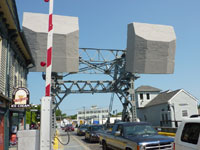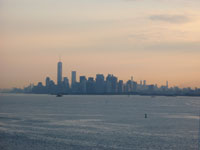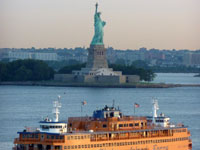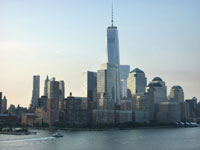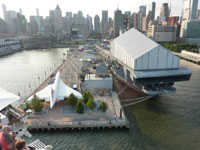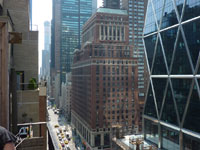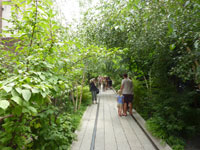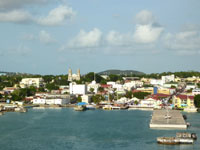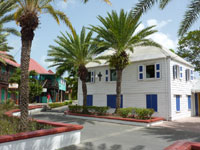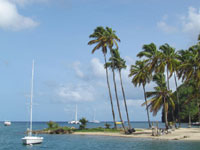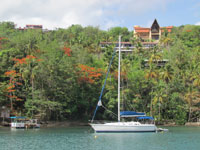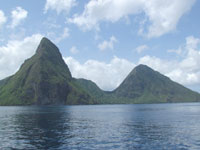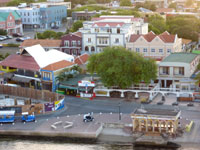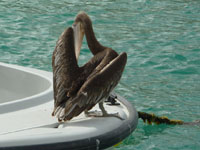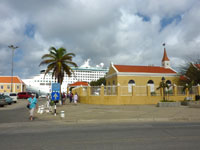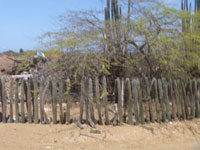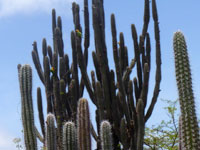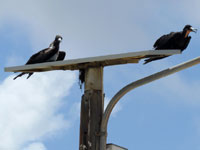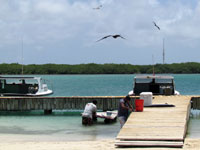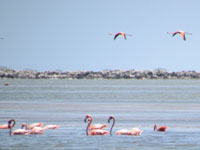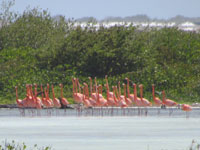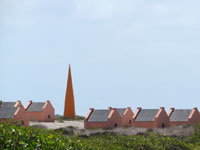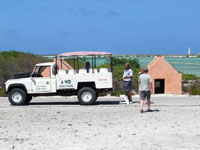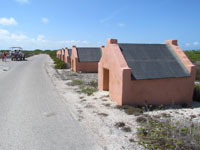A half-world cruise on Dawn Princess in July and August 2014 from Southampton
to Auckland :
Part One - Atlantic Crossing
Atlantic Crossing (download 620KB PDF file) | Map
Part One: Southampton crossing the North Atlantic Ocean to the Panama Canal
We chose a half-world cruise over the whole one as the first half visited Asia and Europe, places we already knew well and anyway, we thought 105 days would be more than our waistlines (to say nothing of bank account) could bear!
We set sail from Southampton on July 12th and enjoyed a smooth crossing to Ireland (Eire).
Dublin
Our day in Dublin was most enjoyable and we had a great time travelling around on the open top of a hop on/hop off bus in the blazing sunshine.
There are many beautiful old buildings in classical Greek and Roman styles, with pillars and porticoes and the most extraordinarily intricate carvings. One in particular caught our attention as it was built entirely without windows, the only light coming in through a glass roof. It was the Bank of Ireland building in the old days but is now a museum. Of course there were lots of churches and two cathedrals, one Catholic and the other Protestant, all very ornate and built by wealthy merchants and manufacturers. Guinness was one of the main benefactors and their huge brewery still covers a vast area of the city. There were also many extravagant modern buildings, dating from the boom immediately before the bust of the global financial crisis.
Ireland went very quickly from being one of the richest nations of Europe to one of the poorest. Dublin seems to have made a good recovery, however, and certainly it appeared to be prosperous, vibrant and lively. The people are fun and friendly and we really enjoyed our visit. A highlight, for us was to find a tucked away museum called the Marsh Library, with thousands of ancient books dating back to the 15th century. It was in a tiny unassuming building which would be easily overlooked and, indeed, we were the only visitors until a Japanese couple arrived. A special exhibition featuring ancient books and manuscripts showing the history of Japan's association with the Europeans is no doubt what drew them. There was a reference to a Huguenot community in Nagasaki, which we had seen when we were there a few years ago. Martin had read about the library but it doesn't appear in many guide books (maybe that's all to the good!).
We sailed away at 9pm and had just got to sleep around 10.30 when there was the most disconcerting juddering and loud noise; we have never heard or felt anything like it and it was somewhat alarming but after a while (probably only about 30 or 40 seconds - which can seem an eternity!) everything went quiet. Another passenger, who had an outside cabin and could hear the engines, said we were at a standstill for about an hour before setting off again. I wondered if we had turned back with a medical emergency, but apparently not. The disturbance was never fully explained so the rumour mill ran wild, the most popular explanation being that we had run aground - hotly denied by the Captain but as he declined to reveal the true cause, many continued to believe in this version of events. Our own suspicion is that he had to rapidly engage reverse thrust to avoid another vessel, though as we had an inside cabin and therefore we couldn't see what was going on, we are probably no nearer the truth than anyone else!
Cobh and Cork
We were a little late into Cobh (pronounced Cove) but it was made up for by the departure time being set back so we'd have the same amount of time in port. With five sea days to follow, we were able to make up the time. Sailing in to Cobh was a lovely experience as the town is on several terraces climbing up the hillside, with rows of houses in different pastel shades. There is a huge church and attractive stone fish-landing docks, with traditional fishing boats which looked as old as time. We decided to get the train into Cork from the dockside station and save exploring Cobh until the afternoon. We were amazed that Irish Railways were so well organised that they ran additional services all day as there was a large cruise ship in.
This worked like a charm, and we enjoyed a lovely half-hour run along the shoreline. We passed pretty fishing villages with rows of houses painted in different colours and also farmland and deserted beaches. There were families of rabbits in the fields and, with the odd small castle popping into view, it was all very picture-postcard. Almost every building along the way, as well as in Cobh and Cork, had window boxes and hanging baskets with flowers of every imaginable colour cascading from them - quite beautiful.
In Cork we caught a hop on/hop off bus and travelled round for the hour and a quarter it took to complete its circuit, listening to the excellent and amusing commentary; the guide had noticeably visited nearby Blarney Castle and kissed the stone! Cork has obviously been harder hit by the recession and has not had the resources poured into it that Dublin has to aid recovery. The churches and cathedral were, of course, all architecturally magnificent and in a good state of repair and one, Holy Trinity, was particularly beautiful. I confess I have a problem with so much money being spent on the church while the people are clearly in need. The number of not only empty, but very run down shops and businesses was quite distressing, even in the main commercial areas, with some big-name companies’ premises being abandoned.
From a distance, the colourful terraces of houses were very attractive
but close to, we could see that many were fading and the paint was peeling,
with wooden doors and window frames damp and rotting. It was sad to see
and we were surprised that the people were not more depressed. Instead,
they were very cheerful and friendly, so their reputation for warm heartedness
is well earned. They are extremely talkative too! We had coffee at a nice
cafe in the old English Market and shared a table with a very pleasant
local woman whose accent was so thick you could cut it with a knife, but
as she had as much difficulty tuning into ours we were quits and once
we'd spoken for a bit the conversation flowed.
Back at Cobh, in honour of Australia Day (the vast majority of passengers
were Australians), the town pulled out all the stops, even including NZ
in their festivities. The town band came and played a jolly selection
of music including Waltzing Matilda. The people of the town gathered in
great numbers and gave us a terrific send-off, waving Australian and NZ
flags It was all so heart-warming nice and my prejudices against the Irish
have been blown away, in spite of having been harboured since the 70s
when 'The Troubles' were at their height.
Five days at sea, which passed surprisingly quickly and smoothly, eventually brought us to the Eastern Seaboard of the United States.
Boston, Massachusetts
Boston was our first port-of-call in America. We had to clear USA immigration which, from past experience, we expected to be a real chore. Although the queue stretched literally from one end of the ship to the other, it went surprisingly well and instead of taking the 1 to 2 hours we had experienced on previous cruises, we were all done and dusted in 25 minutes. We were ready to go ashore and were off the ship in no time. We have been to Boston a number of times so didn’t feel the need to revisit the sights. Rather, we designated it our ‘Shopping Day’ and got a taxi to Cambridge where we knew there was an excellent shopping mall. Regular readers will remember that we try and do this once on each trip as we live a very long way from such ‘luxuries’ as malls and the vast choice of shops they offer. As usual, after less than an hour we couldn’t wait to get out of the artificial environment, having managed to complete our shopping in record time.
We had a delicious picnic lunch of lobster roll - a 'must' in Boston, sitting at the edge of the river basin, watching the fountain and the river boats before treating ourselves to a taxi back to the ship. Unfortunately for some reason best known to the 'Powers that Be' at Princess Cruises, we only had a short stay in Boston, leaving at 4pm, which must have been very frustrating to those visiting for the first time as it is a fascinating city with a rich and colourful history.
We were tempted to a boat ride on the Charles River but the hour the trip took would mean cutting it fine getting back to the ship, if we couldn't then find a taxi back or it broke down! Boston taxi drivers are a breed apart and well known for their chattiness - unusually for America they actually speak English. The one we got going out was a real archetype, with an opinion on everything and tales of people he’d had in his cab; he was quite funny and kept up a running commentary on the poor driving of the other cars on the road, as well as how close we were to his estimated fare - he was spot on at $17.80 (plus tip, of course!). The one we got back treated us to a run-down of the various loves of his life and how they all ended up with other people. Now he has a lovely lady who is perfect in every respect except that she lives in Honduras while he lives in Boston - we didn't like to point out the obvious drawback to that arrangement but wished him well when he dropped us off. He had taken a different route back, through some of the older parts of town, and I wondered how much the fare would be but it was exactly the same as going so I misjudged him. He told us he felt blessed that he had two such nice passengers as us and that he knew his life would work out better now - what a responsibility!
We were back on board by the appointed time of 3.30 but one of the tours was late back so we had to hang around for a bit. We weren't bored though as the cruise terminal is right at the end of Logan Airport runway - literally, the photo shows how close we were with no trick photography or long lens work needed. The planes were coming over us thick and fast, so low we could even read the lettering on the undercarriage - it reminded me of shopping in Lion Road at the end of the Kai Tak airport runway in Hong Kong. At one point there were two planes coming in to land at the same time and we watched the smaller one overtake the big one - luckily they were making for different runways or it might have got interesting! A second later, a third aircraft - taking off - appeared to get in the middle of them, though as sparks didn't fly it must have been on a slightly different trajectory; who knew plane watching could be such fun? Even though we were all adults, everyone was waving to the pilots and passengers. We wondered what they thought seeing a huge cruise ship right in their line of fire - just as well none of them came in any lower or we would have lost our funnel!
A weird phenomenon which occurs every afternoon in Boston is a thick bank of fog that rolls in, meaning that the planes disappeared for a few moments and you could imagine a mystery story about them not reappearing - it looked quite eerie. Evidently it rolls all the way down from Nova Scotia at around the same time every day. We saw a glimpse of a three-master sailing ship through the fog and then it disappeared, and I thought of a story about ghost ships. When we sailed away about half an hour later and came out the other side of the fog bank, it was there, white sails sparkling in the sunshine and I was a little bit disappointed that it hadn't really been a ghost!
A day at sea was followed by a visit to Connecticut.
New London, Connecticut
We arrived an hour late due to fog and also because of having to make a long stretch of the journey through the National Oceanic Atmospheric Administration reserve, where large ships are restricted to 10 knots at this time of year to protect the Atlantic Right Whale. We were there at the time they're passing through and are at their most vulnerable. Apparently they are slow moving, lazy and not particularly bright so don't get out of the way of danger such as ship strikes very easily. I rather like the sound of them and we certainly didn't have a problem with playing a small part of their preservation, especially as there are thought to be only about 400 left in existence.
New London is home to the US Coast Guard Academy and also the US Navy Submarine fleet and workshop and we watched the several Coast Guard boats, bow-mounted machine guns manned and at the ready, busy themselves around us as we were sailing in. Then one of them came alongside and we were boarded by a bunch of the Guards, armed to the teeth (well, they carried side arms anyway) who proceeded to make their way leisurely round the deck, ostensibly searching for contraband but really, we suspect, searching for the slap-up breakfast they'd been promised! They were grinning and chatting and one chap felt quite aggrieved as he said it spoiled the image! I hope their searches are more diligent when they are on patrol in Somalia or the drug routes from South America….
After that bit of excitement, there was more when a submarine, with several escort vessels sailed out towards us and passed us by very close on the port side. The crew were standing on the top of it around the conning tower and although we all waved they maintained their dignity. They gave us a blast of their horn as a salute so we gave them an even louder one lasting twice as long in return. We also passed some docked subs and a few in dry-dock or other maintenance facilities. Someone thought the Coast Guard had come aboard to make sure we didn't take photos but that wasn't the case at all and we snapped away like mad.
When we finally reached our berth we were piped and drummed in to the tune of Yankee Doodle Dandy amongst others, played by the Coast Guard's band - and very hot they looked in their authentic 18thC uniforms; the temperature must have been 30C at 11am and got hotter as the day progressed.
There is a high-level road bridge across the harbour with a lower rail bridge below it; the centre section of the rail bridge lifted up under the road bridge when there were no trains due so that shipping could pass under it.
Our good friends Sam and Niloufer were waiting for us as we got off
the shuttle bus, provided free by the town, and it was lovely to see them
again - last time was in 2007. We went to Mystic Seaport, about 10 miles
away, where we had a lovely lunch at the same pub as last time and caught
up with our news.
Mystic is very typical of an historical New England whaling port, with
wooden buildings reminiscent of Mangonui and Russell in New Zealand. It
is also home to a museum of old sailing ships but that is very expensive
to visit and is only really worth it if you have all day. There is a spectacular
lift-bridge weighted with huge concrete blocks and I felt quite apprehensive
walking under them but as they have been there for about 100 years without
mishap we thought we'd probably be safe and so it proved.
A pleasant day passed all too quickly and soon it was time to say goodbye and return to New London and the ship. We'd been there before and we thought they'd done a great job of bringing it up to a high standard after being hit badly by the recession. We liked that empty shops and building were painted with murals so they didn't look so desolate. One mural in particular has an amusing history as it is of some artistically-draped Greek ladies, the draping not leaving an awful lot to the imagination. When it was first painted, certain less than broad-minded citizens would drive a long way round in order to avoid sullying their eyes with such filth. Many also covered their daughters' eyes to prevent them seeing it but eventually they realised the end of the world had not come and are now quite reconciled to this rather fine addition to their town's artwork! The volunteers, who staffed the pier and welcomed us in the morning, greeted us on our return and thanked us for visiting. Our enthusiasm for their town and the improvements went down very well and the leader told us she was going to a meeting that night for a debriefing and asked if we minded if she quoted us.
We sailed off into a beautiful blood-red sunset and after dinner fell into bed, exhausted. Early next morning we arrived at New York.
Manhattan, New York
At dawn, we sailed under the Verrazano Narrows Bridge and the Manhattan skyline gradually came into view, bathed in a pearly pink light - it has never looked more magical. The Statue of Liberty and Ellis Island both showed clearly in the fabulous light of a clear day, already 20C at 6am; it rose to a sunny and steamy 30C for the rest of the day.
We moored right alongside the decommissioned aircraft carrier USS Intrepid. It is now a museum of naval aviation and the deck was literally cluttered with planes of all types and ages. There was even a real Concorde parked on its own plinth, right at the corner of the dock and when we sailed in it looked as though we were going to crash into it.
Our friends Dick and Denise met us and even though it's about 30 years since we saw them, we recognised each other immediately; they hadn't changed a bit, and we can thank Facebook that they recognised us - Martin didn't have a beard then and I was about 40kg heavier.
Then came the first of the many ‘100% NY’ experiences - just like in the movies or TV shows: Dick stepped out into the middle of the road and hailed a yellow cab to take us to their apartment building on W 57th Street (near Central Park), where we were shown in by a uniformed doorman. We sat drinking iced home-made lemonade and catching up on the last 30 years, sitting out on their terrace high above streets echoing with traffic, air horns and sirens, which they no longer notice.
We walked through their block to the next street then through the new Warner building and out into Columbus Circle where more kamikaze action got us another cab to Central Park. We couldn't get right into the park in the cab as the road was closed so the driver swerved to a halt right on a corner and we hopped out pretty smartly and made it safely to the sidewalk (see, I can write American). A short walk through a tree-lined avenue brought us to an underpass where some filming was going on: Direction from cameraman to the female of the two actors, who seemed to be spending the entire morning running out of a tunnel, "Now do it again and I want more hair action". We spent the rest of the walk speculating what sort of 'hair action' he had in mind!
The restaurant they had booked for lunch was right on the boating lake and we enjoyed the view of the gardens and watching the rowers. We had a typical waiter: "Hi, my name is (forgotten) and I'll be serving you today. Our lunch special is Lobster rolls (carried on at length listing ingredients and method of making with lots of 'folding' and caressing - oh, no he didn't quite say that but you get the picture). He was quite deflated when D & D said they preferred their lobster plain with melted butter and we said that as we'd had it two days running we would have something else...
Dick ordered white wine and when the waiter recited a list of every white wine known to man as well as its provenance and characteristics, he said the Sancerre would be fine. He then got treated to a lecture about Sancerre and Sauvignon Blanc, so we quickly interjected that we were from NZ and knew our Sav Blancs, to try and prevent him making a fool of himself, but he had his spiel and he was going to use it. Orders for a Negroni and two iced teas made him realise we were not entering into the spirit of the thing and he gave us all up as a bad job. It did mean he left us unmolested while we ate and turned his attentions to the next table ... by then we were having difficulty not disgracing ourselves ... best entertainment we've had for a long time and just like the waiter in the movie ‘LA Story’.
Another taxi took us to the elevator for the High Line - one of New York's best kept secrets. It is a disused elevated railway running up the west side of Manhattan and which has been converted to the world's longest, thinnest park/botanical garden. The rails have been kept in place and in some areas even the sleepers. Mostly, however, the gap has been filled in with board walk and numerous different species of plants. It's a lovely airy space to walk high above the busy, smelly, congested streets and every now and then there are clusters of wooden loungers, with the ends made of old train wheels, placed on the rails. I don't think they moved but it was a nice way to reference the history of the walk. It was very hot and humid but much pleasanter than it would have been walking the same distance on street level.
D & D are members of a Trust to preserve an historic fire-fighting vessel, the John J. Harvey, and had even tried to get the boat to come out and give us a traditional fire-hose welcome into port but it was going to cost $3000 and as they couldn't be sure we'd be on deck to watch, scotched the idea ... wouldn't that have been fun! Instead, we walked to pier 66 where it is moored and where there is a bar and restaurant (with a real railway caboose in the middle of the space). It was about 5pm by now and we'd just settled with our drinks for a final hour's chat when the whole place was invaded by a huge crowd of 20-somethings who proceeded to get louder and louder as the buckets of beer and cocktails went down. Party Central indeed; we were old enough to be their grandparents and felt it. Apparently it is a real Manhattan hot-spot with the young and unattached.
It was sad to say goodbye to our friends after such a wonderful day but we think we have got them planning a visit to NZ and look forward to that.
As we sailed away towards the Caribbean Sea, the black clouds which had been gathering since 6 o'clock finally broke and there was a spectacular thunder storm with dramatic lightning pointing out the iconic New York landmarks. Unfortunately we had gone in to dinner and could only see it through the windows but people who saw it from the deck said it made the perfect end to the day and we envied them their photographs.
Antigua, Leeward Islands
We sailed for three days from New York, which entailed passing through the Bermuda Triangle on our way to Antigua and we wondered if we would make it or disappear into a parallel universe, as have so many ships before us. There was, therefore, much relief as the island came into view and we knew that all was well!
We are lucky enough to have visited this island a couple of times before so felt no need to go on a trip out of town. We had a walk round the capital, St John, and looked at the few souvenir and Island-style clothing stores which had opened for the benefit of passengers, it being a Sunday when everything would normally have been closed. Indeed, the 'proper' shops, library, Post Office, etc. were closed and, apart from the cruise passengers, the town was quiet and deserted. It did mean that we were able to amble around in peace and see the cheerfully colourful wooden buildings and luxuriant bougainvillea and palm trees, which was a treat. In spite of all this cheerful colour, Antigua is a poor country and away from the tourist areas the jollity of the local inhabitants, as seen in the stall holders trying to persuade one to buy their rather tacky wares, was not at all apparent.
Antigua has 365 beaches, conveniently one for each day of the year, all beautiful and safe for swimming but it is the history of the island which is its real attraction. The island was formed by volcanic eruption and the first settlement is thought to date from 2400BC. More recently, Christopher Columbus landed here and in 1632 it was colonised by the British. In the 18thC the Royal Navy made Antigua its base on the strength of the excellent deep-water harbour known as English Harbour. Admiral Lord Nelson was responsible for establishing the naval base, known as Nelson's Dockyard, the ruins of which can still be visited. The restored buildings are now a National Park.
Bird Island, a tiny islet off Antigua, is famous for the astonishing number of brightly coloured birds which make their home there. Early sailors were amazed by the spectacle and took home tales of their fabulous plumage, unlike anything they had seen before.
Back on the ship, we watched the elegant frigate birds wheeling and swooping around us. They are huge and graceful and seem to glide so slowly - until you try to take a photo, when you realise that they are actually moving very fast indeed.
St Lucia, Windward Islands
We moored at the main town of St Lucia, Castries, which is another colourful place with its smart buildings and boats as well as some rather picturesque rust-buckets. As if the painted boats and buildings weren't colourful enough the hillsides were covered in flame trees in full bloom. It certainly appeared to be a lot more prosperous than Antigua,
We had booked a catamaran tour through the ship as we wanted to see the Pitons and one can only really do so from the water. Last time we were here, it was raining with low clouds and nothing could be seen. What a contrast this time! It was sunny with blue skies all the way, which just made the trip even better. We called in at the beautiful Marigot Bay, reputed to be the prettiest in the Caribbean - it was lovely but, except for the coconut palms, no nicer than our own Mill Bay. There are plenty of even more beautiful ones around Tahiti, Moorea and Bora Bora and it will be interesting to see what those who raved about Marigot will say when they have seen Moorea. Then we had a swimming stop at another bay, where the number of old fellas in budgie-smuggler bathers was quite disturbing and they, or their wives, really should have known better! While we were anchored a few men and boys paddled out to us, selling conch shells, fruit, and souvenirs. Sadly, they were in bright coloured plastic boats, not the dugouts or outriggers we used to see when we came here all those years ago; not the same thing at all.
A little further on round the coastline, we saw the Pitons in all their glory. The tall, thin one is called Petit Piton and the short, stubbier one is called Grand Piton. They are hardened lava mounds and each is more than 2000 feet high. It is possible to climb them but you need to be an experienced climber and get licenses, etc. as they are a UNESCO World Heritage Site so numbers are strictly controlled; not something which caused us any inconvenience, I might add.
We were on the way back to port as we spotted what we thought were dolphins racing through the water but the Captain told us they were porpoises. They are very sleek and fast but don't leap and play like dolphins and they actually dived below the waves when the boat got near and were lost to sight very quickly so not everyone saw them.
Our vessel was called Jus' Tango and the other two in the fleet are called Tango Too and Mango Tango; all are party boats and definitely lived up to their reputations. There was plenty of cool rum punch, fruit punch, Sprite and Coke as well as water, all included in the price, plus the very good local beer for US$3, so no excuse to get dehydrated. They sensibly didn't start serving the alcohol until after the swimming stop but actually everyone was very moderate and there was none of the drunken tomfoolery we had feared...maybe because we were not the oldest on the trip by 20 a good years! They also had a bottomless tray of cheese or tuna sandwiches, so plenty of blotting paper for those who did indulge in the rum, which we were told was quite strong. Loud reggae music was played the whole time but although we're now even deafer than before, it went along with the party atmosphere and everyone was singing along - including us. One of the crew, a zany girl with amazing dreads, got almost everyone dancing and also gave us a spirited song and dance routine of her own - she was absolutely the right person for the job!.
Bonaire, Netherlands Antilles
On arrival at Bonaire, which is situated at the southern end of the Caribbean, east of Curacao and off the coast of Venezuela, it was easy to see why the Dutch felt at home here since it is one of the flattest islands in the Caribbean. Famous for its salt pans and flamingos, the national bird and emblem, we were not fooled by the salt mountains glistening in the sun which could be seen long before buildings became discernible; earlier visitors had thought they were snowy peaks, which would, indeed, have been a wonder in this hot and sunny part of the world!
Bonaire has a thriving main town, Kralendijk, with lots of souvenir, clothing and other fancy shops. I had seen a dress I liked in Antigua but it was very expensive. I found two identical dresses in Bonaire for a quarter of the price but couldn’t decide which colour to buy so ended the debate by purchasing both! A much-needed haircut and pedicure were on the ‘to do’ list and I was able to get an appointment at a very ‘local’ salon where I had one of the best haircuts ever. It needs cutting again now and I am trying to work out how I could get back there for another the same! So, as well as enjoying all that the island had to offer, I felt much better groomed when we left than when we arrived.
Meanwhile, Martin took a 4x4 tour for a closer look at the salt lake and flamingos on the southern part of the island. It was said that the first part of the journey required 4x4 vehicles but, in truth, the roads were no worse than our local unsealed roads and the second part of the journey was on tar seal. This was frustrating as I didn’t go on the tour having been warned it would be very rough going. The Land Rover was driven by a dreadlocked ex-policeman who was also an excellent guide. Martin had close up views of the many cacti, wild goats, iguana and donkeys in the first part of the tour and then a huge number of frigate birds at Lac Bay feeding on the waste from fishermen gutting a large Wahoo.
A trip off-road at the salt pans resulted in a reasonably close view of hundreds of flamingos on the salt lake which is home to one of the world’s great populations of Flamingos. The flamingos clearly thrive on their salty environment and presumably the same conditions which make the water pink contribute to their brilliant colouring (now that we know it isn’t due to eating shrimps!).
The trip to the salt pans also provided an insight into the ‘harvesting’ of this gift from the sea and an appreciation of how the process has changed over the years. From 1633 to 1862 when slavery was abolished, salt used to be collected from the evaporation pans by slaves. They lived in appalling conditions, in tiny huts not much bigger than a child’s play house, with up to 10 people to a hut. By 1837, Bonaire was a thriving centre of salt production which had grown so large that four obelisks were built near the Salt Lakes to guide ships coming in to load. Female slaves would then carry huge loads of salt on their heads to the ships for loading.
It was intriguing to see that the water turns pink during the evaporation period, though the salt which is the end result is blindingly white. Pink salt is collected elsewhere in the world and we wondered if this was a result of premature collection of the crystals or different properties in the sea water at these places. After some research we discovered that the pink salt isn’t the same sort of sea salt at all, but is mined from salt caves formed millions of years ago from ancient sea beds. But we still don’t know why sea water turns pink during evaporation and assume it must be to do with the tiny organisms living in the water.
Bonaire is another island which revels in its sunshine and celebrates it with brightly painted buildings. Particularly noticeable is the orange hue, mainly on government buildings, a compliment to the Dutch Royal House of Orange. The Dutch influence is very obvious and the language is widely spoken, in addition to Spanish and the local patois, Papiamento. This is a mixture of Dutch, Spanish and Portuguese spoken with an African rhythm and no, we didn't master it in the day we had on the island.
An interesting feature of Bonaire, which sets it apart from the other Caribbean islands, is the flora. Cacti considerably outnumber the trees, even the usually ubiquitous coconut palms, of which we counted not one, except in some gardens. The prickly plants, together with some yellow-flowered thorn bushes, provide grazing for the wild goats which abound. The cacti come in a variety of shapes and sizes but particularly prevalent are the ones known colloquially as 'organ pipe'. These tall, upright, single shaft cacti make excellent intruder-proof fences.
We left in the early evening and watched the sun set as we started our voyage to Ecuador via the Panama Canal
About five hours out of Bonaire, just after we went to bed, there was a call from the bridge for the second officer to report and about half an hour later for the stretcher party. It was obvious that there was a medical emergency of some sort and we thought we might have to turn back to Bonaire. We went back to sleep and in the morning the Captain came on the loudspeakers to tell us we'd made a rescue at sea.
A yacht, the Blue Whale, reported a sick crew member and the rescue helicopter had been sent out from Curacao but needed us to make our way to the stricken vessel and stand by in case the wind and waves were too high for an airlift. This proved to be the case (it was the lumpiest sea of the voyage so far) and we put out a fast rescue boat and emergency response team and managed to transfer the patient and get him on board the Dawn Princess - those people deserve a medal for even attempting it in those conditions and the Captain made a point of commending them. The helicopter tried to winch the patient from our deck but even that was impossible in the high winds, so he was admitted to the ship’s hospital and was later off-loaded in Panama. He was extremely fortunate as Dawn Princess has the most sophisticated and well-staffed hospital in the fleet - the only thing they can't do is CT scans and MRIs. I suspect he was in a better place for the acute phase of his illness than had he been taken to Curacao.
We feared we might have to miss the Ecuador visit but apparently we were only running two hours late and the Captain was able to get a new slot for our transit of the Panama Canal. In fact, it was better as we started the transit at 7am instead of 5am; a much more civilised hour to be up and about. As we made our way towards the Canal, we were entertained watching 'flying' fish leaping over the waves in their thousands. Actually I am not convinced they were true flying fish as they were like tiny silver needles and didn't display the fins and wings normally seen. Whatever they really were, they were fascinating to watch.
Panama Canal, Panama
We arrived at the entrance to the canal only two hours late, which was pretty good going, and we started going through the three Gatun locks at about 9am. We crossed the Gatun Lake at the prescribed snail’s pace…. and this is where we will leave you - look out for crocodiles!
Part 2 – The South Pacific Ocean coming soon.
Atlantic Crossing (download 620KB PDF file) | Map
Click on a thumbnail to enlarge the image and then click on arrows to scroll through a slide show of more images.
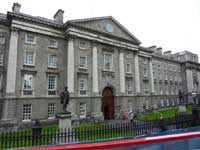
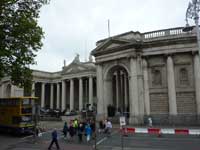
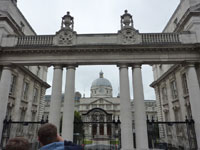
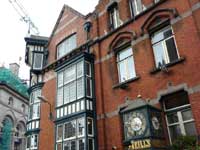
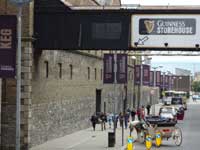
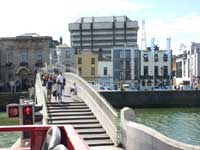
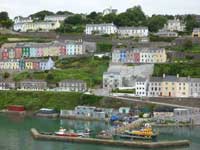
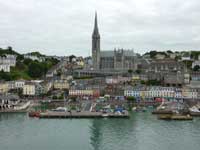
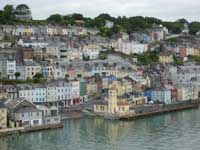

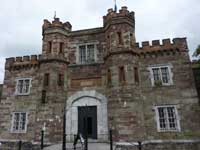
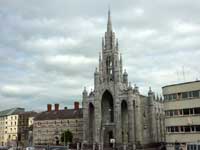
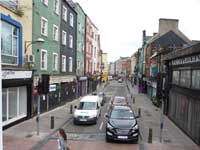
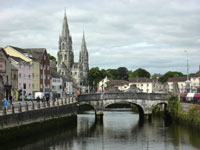
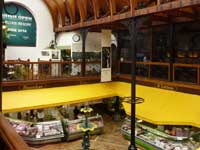
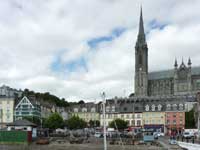
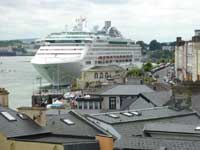
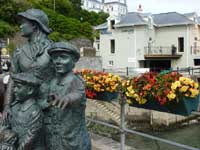
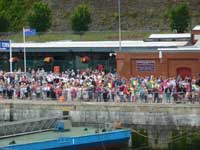
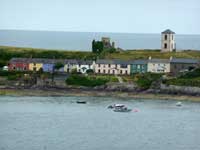
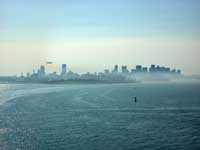
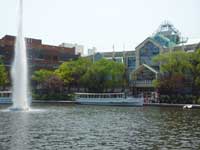
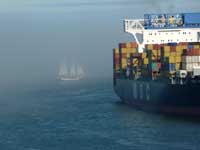
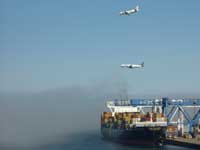
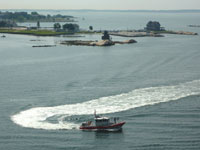
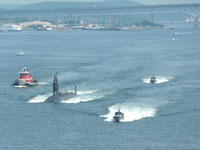
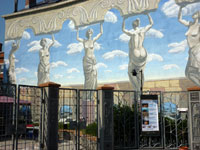 >
>
